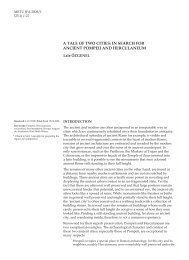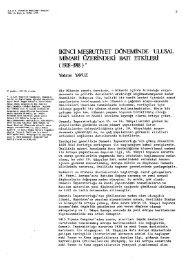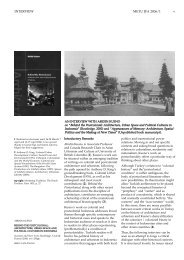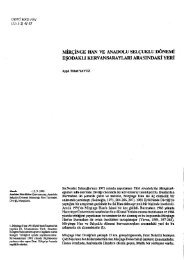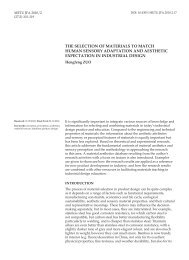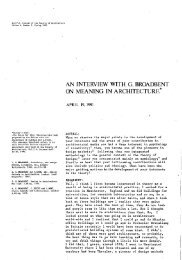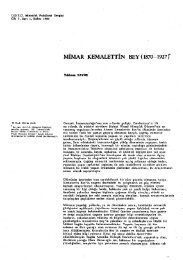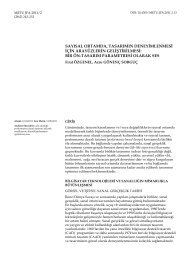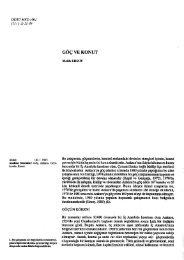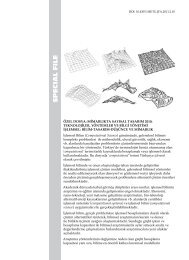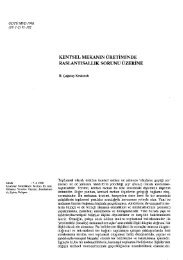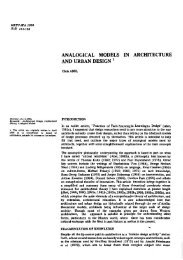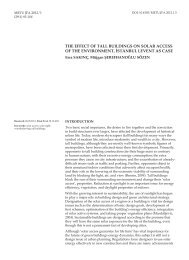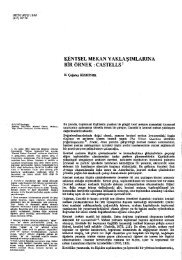MODERN VE SKOLASTİK: RUSKIN'İN İNCELENMEMİŞ BİR ÖNSÖZÜ
MODERN VE SKOLASTİK: RUSKIN'İN İNCELENMEMİŞ BİR ÖNSÖZÜ
MODERN VE SKOLASTİK: RUSKIN'İN İNCELENMEMİŞ BİR ÖNSÖZÜ
You also want an ePaper? Increase the reach of your titles
YUMPU automatically turns print PDFs into web optimized ePapers that Google loves.
<strong>MODERN</strong> <strong>VE</strong> SKOLASTÝK: RUSKIN’ÝN ÝNCELENMEMÝÞ BÝR <strong>ÖNSÖZÜ</strong> METU JFA 2006/1 39<br />
Received: 26.01.2006<br />
Key Words: history of architecture; John<br />
Ruskin; admiratio; reading; Biblical exegesis;<br />
Gothic; Neo-Gothic.<br />
WAINRIGHT, C. (1981) Architect-Designers from Pugin to Mackintosh,<br />
The Fine Art Society; Haslam & Whiteway, London.<br />
WIHL, G. (1985) Ruskin and the Rhetoric of Infallibility, Yale University<br />
Press, New Haven.<br />
WILTON-ELY, J. (1986) The Rise of Professional Architect in England, The<br />
Architect: Chapters in the History of a Profession, ed. by S. Kostof.<br />
Oxford University Press, New York.<br />
WÖLFFLIN, H. (1915) Kunstgeschichtliche Grundbegriffe, Sanat Tarihinin<br />
Temel Kavramlarý, çev. H. Örs (1995). Remzi Kitabevi, Ýstanbul.<br />
<strong>MODERN</strong> AND SCHOLASTIC: AN UN-RESEARCHED PREFACE BY<br />
RUSKIN<br />
In the brief Preface to the second edition of The Seven Lamps of<br />
Architecture published in 1855, John Ruskin identified four kinds of<br />
admiration viewers might feel regarding an architectural work:<br />
Sentimental Admiration, Proud Admiration, Workmanly Admiration,<br />
Artistical or Rational Admiration. Unexplored by Ruskin critics, the<br />
Preface poses significant interpretive problems: neither the Preface nor the<br />
elaboration of the fourfold typology contained in it bears reference to the<br />
content of The Seven Lamps which had first appeared in 1849. The key<br />
lies in the Preface’s explicit and implicit references to The Stones of Venice<br />
which Ruskin had published in 1853 and to the latter work’s all-important<br />
middle chapter entitled “The Nature of Gothic.” Read in conjunction with<br />
“The Nature of Gothic,” the 1855 Preface emerges as a belated gloss to The<br />
Stones, witnessed above all in the coalescence of the complementary<br />
notions of production and reading of the Gothic in both articles. “The<br />
Nature of Gothic” further offers the clue to the source of the fourfold<br />
typology and to Ruskin’s employment of the term admiration by<br />
identifying the reading of architectural works with textual reading, viz.<br />
the reading of Gothic cathedrals with the reading of epic poetry. The<br />
representation of Gothic cathedrals and the reference to Dante offer<br />
certain proof that Ruskin found the prototype of the fourfold typology<br />
and admiration in the Scholastic elaboration on the four levels of Biblical<br />
exegesis and on admiratio as, again, a mode of reading the Bible and<br />
viewing religious painting. In fact, Ruskin’s treatment of the fourfold<br />
typology and admiration follows as it were in verbatim fashion the<br />
description of Dante’s adaptation of the Biblical modes to the reading of<br />
his Divine Comedy in the “Epistle to Can Grande” as well as Dante’s<br />
sources in Aristotle, Aquinas, and Bonaventure. Ruskin’s radical<br />
reduction, found much puzzling by critics today, of the value of<br />
architecture to the value of the painting and sculpture contained in an<br />
edifice underscores the medieval conception of admiratio that had<br />
particularly flourished in the era of Gothic architecture. Not only will<br />
these findings compel us further to revise our notion of Ruskin’s stance<br />
toward the Evangelical Protestantism of his day as well as add to the<br />
demonstration of the author’s commitment to Gothic architecture, but<br />
they equally call for re-investigating Ruskin as a major force in the<br />
assimilation of architecture into the then-burgeoning discipline of art<br />
history.



